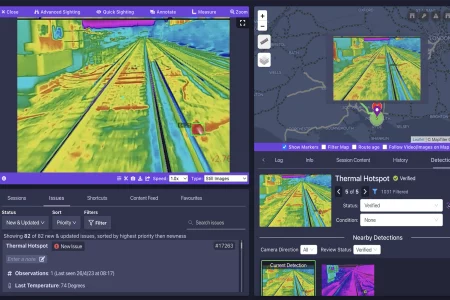CASE STUDY
Network Rail
How Network Rail worked collaboratively to bring advanced video capability into the industry

Network Rail used AIVR technology to help face the challenges of monitoring and maintaining the rail network during the Covid-19 Lockdowns; now, they are continuing to use and advance the system to increase safety and remote condition monitoring longer term.
The Challenge
Cameras deployed onto trains have been around for many years, and have provided valuable imagery of the rail network. Deployed on Network Rail measurement fleet and also on operator’s in-service fleet, the data captured by these devices has been historically challenging to access; often stored on hard drives or manual devices, kept onboard trains or requiring specialist knowledge to access and download the information. Adding further obstacles, these hard drives containing critical visual data from the track would be processed to then be couriered between depots and offices, causing delays for workers looking to access this data whilst restricting sharing capabilities.
With the sudden lockdown in March 2020 however, there was an unprecedented requirement for data to be viewed remotely by engineers, in varying work-from-home locations where handling of physical hard drives was unsuitable.
The Solution: AIVR
Network Rail entered into a technical trial of the AIVR system in late 2019 – the trials were deemed a success, and in early 2020 AIVR was called into operational action across Network Rail.
AIVR Go devices were sent to engineers in a number of depots for them to deploy into train windscreens (working alongside a number of operators), whilst adhering to social distancing in the front cabs or accessing rear cabs. With the success and advanced rate of this data being captured and transmitted to the cloud, NR worked with One Big Circle to continue accessing data, this time from fixed cameras on the IM fleet. By providing the AIVR Connect device to integrate with the onboard cameras, the data stream was no longer stored on the train but was transmitted to the AIVR Platform, where a growing number of users were accessing the imagery needed for remote inspection.
A third type of capture capability soon followed these initial projects, where a Network Rail Tail Lamp Box device was fitted with AIVR hardware, to capture both Forward Facing and thermal imagery of the track for simultaneous review in the AIVR Platform.
In conjunction with the capture from the NR fleet, agreements were made with multiple train operators for data to be captured from onboard their in-service fleet. The operators themselves could also access this data for operational and performance purposes.
The type of data captured and available in AIVR has evolved rapidly, so that Forward Facing, Overhead, Thermal, and Line-scanning imagery can all be accessed in one platform, alongside track geometry data and a wide range of automated fault detection systems. In addition, the AIVR platform has advanced to integrate other data formats including lidar and drone imagery.
In collaboration with Network Rail, over 2,500 individuals from multiple disciplines and organisations have become regular users of AIVR to date, accessing data on a daily basis to help reduce ‘boots on ballast’. By providing critical data online NR estimates that for every hour spent on AIVR a user can remove eight hours of time on site, including the time taken travelling to and from site.
Testimonials
Benefits
Virtual Track Access
Open Data
Increases Safety
Easy to Use
Time Saving
Automated Infrastructure Monitoring
Reducing Boots on Ballast
Seasonal Planning